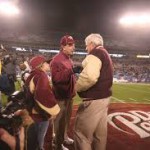The Oregon Ducks football team is one of only a few NCAA teams using a high-tech GPS device for training and practicing purposes called the Catapult. This device helps coaches and trainers keep track of their athletes in ways that haven’t been possible until now.
So, you’re wondering what the Catapult is. Well, the product’s website catapultsports.com says, “Catapult is a physiological/biological monitoring device that allows coaches and trainers to know who is overworked and economize practice by removing the guesswork with scientific performance management. It compares athletes, sessions, weeks and seasons and stops the guessing.”
The athletes wear what appears to be a male version of a sports bra (or bro) with a small attachment between the shoulder blades where the actual Catapult device can be connected. It’s real sleek and not very noticeable, unless you go shirtless.
Other major universities are using the Catapult system for their practices including Nebraska, Florida State and Alabama, to name a few. Florida State’s head coach, Jimbo Fisher, has been more vocal about his use of the device than others; however, Fisher may have taken this a bit too far with television catching a post-game scene where it appears that one of the players is getting his device removed. The NCAA has not made these legal for game days yet. So, it could be considered cheating to use the Catapult during any football game.
Oregon, Alabama and Florida State are each in the Top 4 for the inaugural College Football Playoff. Each team uses the Catapult to know whether practices are going well or not. They see individual effort and can monitor if an athlete is actually fatigued or just being lazy. The coaches can decide whether to push the players or let up.
This technology helps reduce soft tissue injuries during practices. Obviously, a healthier team can perform better throughout the season. This gives the trainers a good idea of how much the individuals can compete and for how long before eminent injury occurs. It may give them an idea how many plays a running back can put in before needing to be relieved with a backup.
The Australian-based GPS system is somewhat of an unknown advantage to training, but it’s nice to know that Oregon has begun utilizing it (although, the extent is unclear). This helps the Ducks get the most out of all of their football players each day leading up to their next big game. As long as the Seminoles are not wearing their Catapults during the game, it shouldn’t put Oregon at a disadvantage in the Rose Bowl.
Top Photo by Craig Strobeck
Related Articles:
Chip Kelly Update: Everything's Good Again ...
Chip Kelly Update: Wailing and Gnashing of Teeth
Shock and Awe -- The Oregon Ducks' Football Hangover Effect
Despite Lopsided Score, Georgia State "Never Stopped Believing"
Hope Springs Eternal for Ducks
Incompetent Pac-12 Officials: How Do You Miss ALL of THIS?
Jason, born and raised in central Oregon, first noticed college football when his older brother attended the University of Oregon. Jason studied English at Southern Oregon University and enjoyed cheering for the school’s team, but longed for that major college game-day experience. That desire slowly blossomed into a fanatical passion for the national feel of college football, especially defending the Pac-12 while challenging conferences like the SEC to step up. He has spent five years expounding on the differences between the two conferences on his blog, buzzbrother2-pac10football.blogspot.com, set up solely for that purpose. Following the Ducks’ recruiting progress in the off-season has made college football a year-round hobby for him. He now resides in Spokane, Washington with his incredibly patient, non-football-fan wife and three children, and works as an MRI Technologist. He can be reached at buzzbrother2@msn.com.



